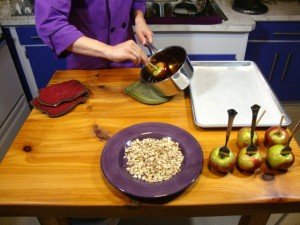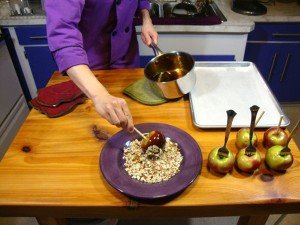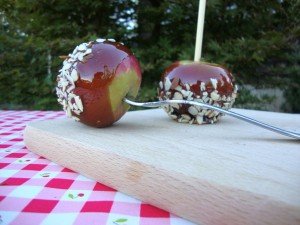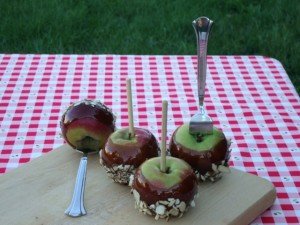
Written by Jason Shriner, the Aubergine Chef
To me, autumn is one of the best seasons for food. We have Thanksgiving, which allows us to celebrate all we have to be thankful for, including nourishing our bodies and souls with wholesome food. Then there is Halloween, which is all about the candy. Thinking of both holidays, I’ve decided to bring you a classic candy apple recipe.
Candied apples are one of the rare treats that are appropriate through all seasons, since apples are so widely available year round. As children we love the sweet crisp candy coating, and as adults we love the healthiness of the apple with a splash of candy.
As a local baker, I’ve been working towards finding ways to remove corn syrup and shortening from my recipes. So when I decided to approach a candied apple recipe, I did a little research on popular substitutes for corn syrup. I have to admit, I was a little floored by the number of possible substitutes: honey, maple syrup, agave nectar, brown rice syrup and golden syrup, just to name a handful.
There’s a different science involved in candy making which makes substituting more difficult. Though sugar’s (and other sweetener’s) main function is to sweeten; it doesn’t stop there. Sugar serves a number of more substantive functions. For candy we’re looking for sugar to provide bulk and substance – a function usually relegated to flour.
What makes candy making tricky is the risk of crystallization, resulting in hard chunks forming in your syrup. There are a myriad of ways to prevent, but the most effective way is to use stable crystal-free syrups, like corn syrup, which interfere with table sugar’s crystallization process. With its flavorlessness and resistance to heat, corn syrup is the superior choice for candy making. But fret not, for every 1-2 ounces of candy you eat you have to nosh through 6-8 ounces of apple, which I think more than balances out the corn syrup.

With all the science behind us, let’s move forward with the recipe. The first step comes in choosing your apples. I particularly like using Macintoshs because they have a nice tender bite, which makes them easy to eat on a stick. Granny smith apples also work well because their tartness balances out the candy’s sweetness.
Once you have chosen your apples, clean them with warm water and then insert heavy-duty dowels or craft sticks through the center. No craft sticks? No problem. A fork works just fine and helps give your dessert an even homier feel. Feel free to experiment with a variety of juices to change up the flavor of your candy coating. You can also experiment with the kind of nuts you’d like to use – granola-style cereal works as well.
While you prepare your apples, combine the sugar, syrup, juice and any seasonings you like in a 4-quart pot. While it’s heating up, you want to carefully stir the mixture with a wooden spoon. If there are any stray clumps of sugar they will caramelize and burn.
Once the mixture comes to a boil, stop stirring as you could cause crystallization. It is important to use a large pot because the thickness of the syrup creates a mixture that easily bubbles up. And under no circumstances should you double the recipe, using the same size pot. If you notice the boiling is a little too intense, reduce the heat. It may take longer to reach the desired temperature but it will be safer.
On that note, make sure kids aren’t around for the boiling of the syrup – the syrup can sputter out, and at 200+ degrees F the hot liquid does burn skin. As for the cook, wearing socks and long sleeves can help prevent skin burns.
You want to make sure you have the right equipment on hand as well. A candy thermometer is good, but a digital thermometer is even better and easier to use. Since you need to keep an eye on the temperature of the syrup, make sure the thermometer clips onto the side of the pot.

Once your syrup reaches 305 degrees F, remove the pot from the heat. You can use the pot for dipping, but what I like to do is pour the syrup into a smaller 1.5 – 2 quart pot with a long handle. Make sure the pot is slightly warm to keep the sugar from getting hard on the bottom. Stir gently with a wooden spoon to make sure the mixture is fluid and consistent throughout.
“Dipping” your apples in the syrup is a bit of a misnomer. What you really want to do is tilt the pot toward you, take the apple by the dowel and twist the apple in the syrup to apply a thin coating of candy.
Once your apple is coated, allow a few drops of candy to drip off. Do not shake as you could fling the syrup back at you. Then quickly drip the candied apple into the crushed nuts if you’re using them. Set the apple on a parchment paper greased with pan release to set up – which only takes about 5-10 minutes. And again kids can watch from a safe distance, but remember the liquid sugar is still extremely hot.
Cleaning up may seem like a hassle but as long as the syrup is only in the pot it’s easier than you think. Simply pour some water on top of the sugar in the pot and bring to a boil. If the sugar is particularly messy just soak the pot in hot soapy water over night. The sugar will dissolve in the water.
And there you have it – instant autumn: just add candy. There are lots of variations to the recipe – such as candying pears, grapes, and even tomatoes. You can even use balsamic vinegar instead of juice for a more grown-up treat. You’ll only need half as much vinegar.
What treats and desserts remind you of autumn? Tell me about it while you kick back and nibble on some candied apples.
Here's the breakdown:

INGREDIENTS: 2 cups (16 ounces) granulated sugar; 1 cup (11 ounces) corn syrup; 1 cup (8 ounces) fruit juice; 1 teaspoon of cinnamon or seasoning (optional); 8 to 10 Apples; 2 cups Roasted and toasted nuts, like almonds or cashews
RECIPE DIRECTIONS:
1. Wash and dry the apples. Deeply insert heavy duty craft sticks or heavy duty lollipop sticks into the tops of the apples through the core.
2. Combine sugar, corn syrup, juice and cinnamon (if using) into a pot and bring to a boil. Continue to cook until the sugar mixture reaches 305 degrees F.
3. Dip the apples into the candy mixture: Tilt the pan toward you and rotate the skewer to coat the outside of the apple. Let excess sugar drip off – flying drips could burn you if you shake.
4. Dip the candied apple into the nuts if using.
5. If needed, warm the syrup over low heat to restore fluidity. Be careful not to cook it or caramelize it.
6. Allow apples to cool completely on a parchment paper lined sheet pan that has been lightly sprayed with pan release.
7. After cooled, wrap with plastic wrap and store at room temperature for 5 days. Refrigeration not recommended – may cause candy coating to get sticky.
Variations:Use apple juice, 1 teaspoon paprika, and cashews; Use pears with the pomegranate juice and almonds (no seasoning); Use grapes with white grape juice and grape-nut cereal (no seasoning) (Use toothpicks);Use tomatoes with ½ cup balsamic vinegar and toasted sesame seeds (no seasoning) (Use toothpicks)

Sources: http://www.rachaelraymag.com/food-how-to/grocery-shopping-tips/candy-apples-gone-wild
How Baking Works by Paula Figoni
Editor's Note: Enjoyed this recipe by the Aubergine Chef? Visit his website theauberginechef.com, where you can view one of his YouTube videos, or sign up for a private or group baking class at Manassas Community Center. Jason Shriner, the Aubergine Chef, is originally from Woodbridge, Va and now lives in downtown Nokesville, where he has an aubergine colored industrial kitchen. Shriner is very involved in the local business community, as a founding member of "Grass Roots Networking" and participates in "Building Bridges Networking." For more information, email Shriner at theauberginechef@gmail.com.
Support Bristow Beat - Donate Today!